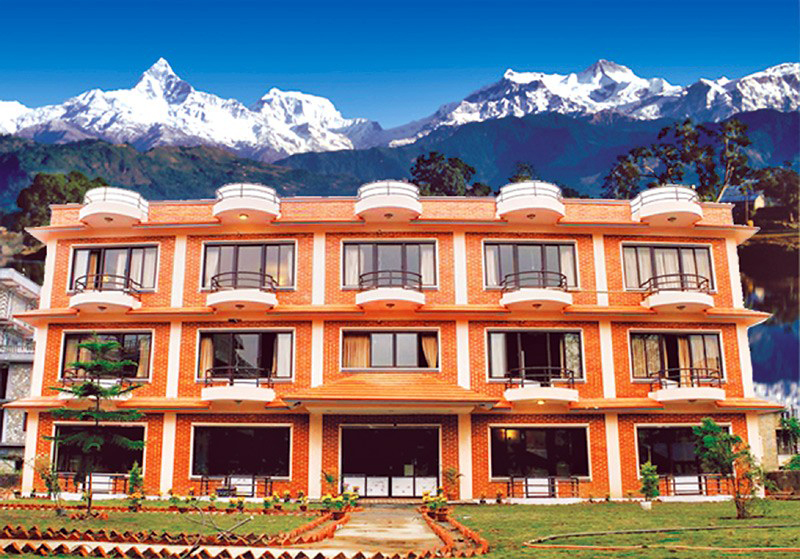Kathmandu, December 29, 2016:Â Pokhara tourism is in an upbeat mood as it gets ready for 2017 because swelling domestic arrivals have helped it rebound from a disastrous slump.
The industry nearly lost heart when hotel occupancy rates plunged to less than 30 percent in 2015, following the twin disasters of a devastating earthquake and crippling trade embargo. Hotels hadn’t faced such hard times since the Maoist conflict (1996-2006).
But in 2016, there was a positive change as domestic adventure seekers started arriving in droves. Pokhara’s hoteliers are now looking ahead towards the future.
“Yes, domestic tourist movement bailed out Pokhara this year,†said Suraj Khanal, director of sales and marketing of Fish Tail Lodge.
“It was a surprising development that no one had imagined. The trend suggests that more and more Nepalis have started touring the country. It is also an indication that the spending capacity of Nepalis has increased, and that the industry can also survive on local business.â€
Frantic tourism entrepreneurs had launched various discount offers and promotional programmes, including ‘Chaliye Pokhara’ (Let’s Go to Pokhara) in a bid to lure arrivals after the earthquake scared away potential visitors.
A five-month-long trade embargo by India following on the heels of the earthquake shattered the industry’s hopes, and hoteliers began resorting to price undercutting to boost occupancy. The average room tariff of luxury hotels dropped below $80 during the peak September-November season in 2015.
“But now, the industry has bounced back,†said Khanal. Fish Tail Lodge is expecting to record a 60 percent average occupancy this year. “Based on the inquiry trend, we are expecting 75 percent occupancy in 2017.â€
“Bookings to Nepal are coming back,†said Anil Shrestha, finance controller at the Hotel Barahi at Lakeside Pokhara. He said that 2016 had been a better-than-expected year for the tourism industry hit by twin disasters in the previous year. “We expect 2017 to be better.â€
The Barahi is expecting to close at 80 percent average occupancy this year. According to Shrestha, Nepali tourists are the new hope of Pokhara tourism as they have started to go trekking in the Annapurna region.
In the past, Pokhara used to be a base for foreign trekkers flocking to the Annapurna Region. Now, it is a destination in itself which foreign sightseers and Nepalis wish to visit at least once in their lifetimes. Pokhara in west central Nepal is the second most popular tourist destination in the country after the capital Kathmandu.
“This year, Nepali visitors accounted for more than 20 percent of our occupancy as most of them had come with a trekking itinerary,†said Shrestha. Besides, increased Chinese arrivals have helped the hospitality industry in Pokhara.
The Hotel Barahi is offering a special 30 percent discount to domestic visitors during the New Year. Shrestha said that room tariffs which had nose-dived in the previous year were yet to recover. “But we are expecting a big rebound in both occupancy and tariff.â€
Traditionally, Pokhara has been known as an adventure destination, but nowadays it is gradually becoming established as a wedding destination. “Hordes of people from Kathmandu, Biratnagar and other key cities are holding their weddings in Pokhara,†said Roshan Khanal, assistant general manager of Atithi Resort and Spa. “Even people from India are coming to Pokhara for weddings.â€
Likewise, incentive tours and corporate groups are on a rising trend. Atithi expects to record 55 percent occupancy this year, and has targeted 75 percent occupancy next year. “If there are no political or other kinds of disturbances, 2017 is likely to be a good year,†he said.
“As Chinese carriers are increasing their frequency, we are expecting a boom in Chinese arrivals next year.â€
In the past few years, Pokhara has seen a dramatic rise in Chinese visitors. “They love adventure. And Pokhara offers all that they need.â€
However, he is concerned by a possible glut of hotel rooms. With hotels and resorts reaching saturation point at Pokhara’s lakeside, tourism entrepreneurs have been casting their eyes towards the valley rim as possible sites for their next ventures. The green hilltops offer spectacular views of the mountains, sunrise over the Himalaya and the sprawling city hugging the shores of Lake Phewa.
Travel traders say that tourists prefer living amid lush green forests and hills, and have strongly encouraged them to invest in such locations.
Currently, 20 tourist-standard hotels are rapidly coming up in Pokhara, and most of them are located at vantage points far from the city.
The private sector is no more hesitant to invest, particularly in Pokhara. There have been massive investments in the hospitality sector. Investments in hotels and restaurants have reached unbelievable levels. Hotel and restaurant capacities have doubled. Within four years, Pokhara has added 8,000 room nights. At present, Pokhara’s hotels can accommodate more than 16,000 tourists daily. There are around 500 tourist standard hotels and many more are in the pipeline.
The period mid-January to mid-March is known for Chinese tourists, mid-March to mid-May for tourists from India, and mid-September to mid-November for tourists from the long-haul sector, particularly European and American vacationers.
There are no official records of foreign and domestic arrivals to the lake city. However, it is estimated that around 400,000 international visitors come to Pokhara annually.
By Sangam Prasain







